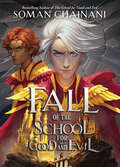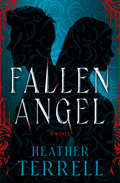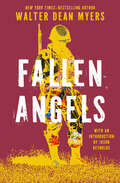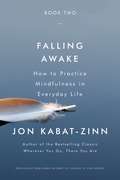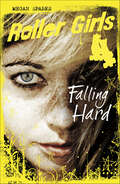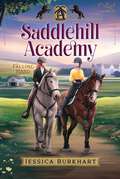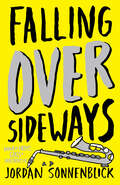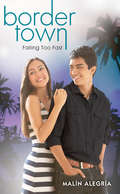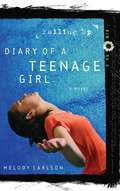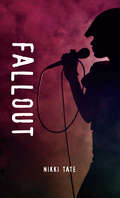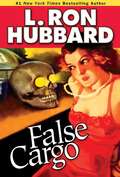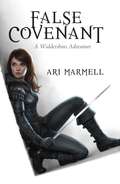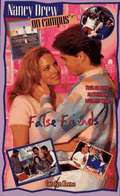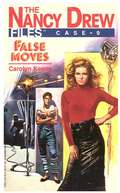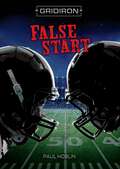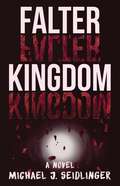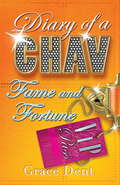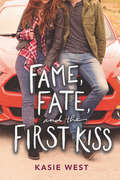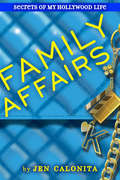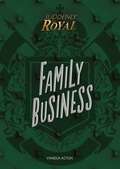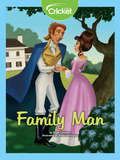- Table View
- List View
Fall of the School for Good and Evil (Rise #2)
by Soman ChainaniTHE SCHOOL FOR GOOD AND EVIL is the #1 movie now streaming on Netflix—starring Academy Award winner Charlize Theron, Kerry Washington, Laurence Fishburne, Michelle Yeoh, Sofia Wylie, Sophie Anne Caruso, Jamie Flatters, Earl Cave, Kit Young, and many others! What rises . . . must fall.Two brothersOne Good.One Evil.In exchange for power and immortality,they watch over the Endless Woodsand rule the School for Good and Evil.Yet all School Masters must face a test.Theirs is loyalty.But what happens when loyalty is corrupted? When the bonds of blood are broken?Who will survive? Who will die? And what will become of the school and its students?The journey that started a hundred years ago throttles towards its end. This final chapter in the duology that began with the RISE OF THE SCHOOL FOR GOOD AND EVIL brings the tale of the twin School Masters to the brink of war and a shocking conclusion that will change the course of the school forever.
Fallen Angel: A Novel (Fallen Angel)
by Heather TerrellA not-so-regular high school girl meets the guy of her dreams and finds her destiny in this supernatural thriller from the author of the Books of Eva. Ellie Faneuil lives a pretty normal life in Tillinghast, Maine, if you don&’t count the far-flung summer vacations she takes with her do-gooder parents. Oh, and her ability to touch someone and know their deepest, darkest secrets. But all that changes when she meets Michael Chase, the very attractive new guy who claims he knows her from a trip to Guatemala. Ellie feels a very powerful connection with Michael, one that only deepens with a kiss and a tiny taste of blood. Apparently, she and Michael are vampires? If that&’s not enough to rock her world, Ellie learns that she can fly. Feeling a fierce urge to use her powers for good is a step in the right direction, especially when Ellie learns the real truth from her parents: she&’s no bloodsucker. She comes from a long line of fallen angels, and there&’s a prophecy that&’s all hers to fulfill . . .
Fallen Angels
by Walter Dean MyersIn this classic coming of age novel from a New York Times–bestselling author, an American teenager faces the gritty reality of the Vietnam War. Winner of the Coretta Scott King Award in 1988&“Heartbreaking. . . . Other authors have gotten the details right, but Myers reaches into the minds of the soldiers. . . . Readers, including those born after the fall of Saigon . . . will reel from the human consequences of battle.&” —Publishers Weekly (boxed review) It&’s 1967, and Harlem teenager Richie Perry is graduating from high school. He dreams of attending college and becoming a writer like James Baldwin. However, reality has other plans. After volunteering for the army, Perry doesn&’t expect to fight in the Vietnam War, but a paperwork mix-up sends him to the frontlines. Perry and his platoon are soon face-to-face with relentless violence and brutality. One false move can mean the difference between survival and death, whether they are fighting the Vietcong or simply walking through the jungle. Overcome by the horrors, Perry begins questioning everything. What were his motives for joining the army? Why are black troops given the most dangerous missions? Why is the United States even there? Perry and his fellow soldiers may have all come to Vietnam for different reasons, but now they share the same dream—to get home alive. &“Recalls Stephen Crane&’s The Red Badge of Courage.&” —Horn Book (starred review)&“As thought-provoking as it is entertaining.&” —The New York Times&“This gut-twisting Vietnam War novel breaks uncharted ground. . . . Myers does an outstanding job of re-creating the war.&” —Booklist (starred review) &“Myers masterfully re-creates the combat zone. . . . War-story fans will find enough action here, though it isn&’t glorified; thoughtful readers will be haunted by this tribute to a ravaged generation.&” —Kirkus Reviews (starred review)
Fallen Angels and Related Readings (Literature Connections)
by Walter Dean MyersApart from the novel on Vietnam war - Fallen Angels - this book features rare letters from soldiers on their life and condition in war zone, letters to families and poems about the veterans who lost their lives.
Falling Awake: How to Practice Mindfulness in Everyday Life
by Jon Kabat-ZinnThink you have no time for mindfulness? Think again. "Thoughtful and provocative.... The relevance of this work is unquestionable, as it leaves us inspired and optimistic that true healing really is possible" (Sharon Salzberg). For four decades, Jon Kabat-Zinn has been teaching the tangible benefits of meditation in the mainstream. Today millions of people have taken up a formal mindfulness meditation practice as part of their everyday lives. But how do you actually go about meditating? What does a formal meditation practice look like? And how can we overcome some of the common obstacles to incorporating meditation into daily life in an age of perpetual self-distraction? Falling Awake directly answers these urgent and timely questions. Originally published in 2005 as part of a larger book titled Coming to Our Senses, it has been updated with a new foreword by the author and is even more relevant today. Science shows that the tangible benefits of a mindfulness meditation practice are impossible to ignore. Kabat-Zinn explains how to incorporate them into our hectic, modern lives. Read on for a master class from one of the pioneers of the worldwide mindfulness movement.
Falling Hard (Roller Girls)
by Megan SparksWhen Annie moves from London to a small town in the midwest, she struggles to fit in. She gets off to a bad start when she makes an enemy of her school's queen bee, Kelsey. But she discovers a new passion, the exciting sport of roller derby, and makes friends with the cool and quirky girls on her team, the Liberty Belles. She also meets Jesse, the friendly boy who works at the roller rink, and Tyler, a cute, all-American sports star.
Falling Hard (Saddlehill Academy #3)
by Jessica BurkhartFrom the author of the Canterwood Crest series comes the third book in a middle grade series about an equestrian boarding school as Abby feels her friends withdrawing and her rival circling.Abby came clean and apologized to Selly for costing her a shot at team captain—but no good deed goes unpunished, especially with her highly competitive teammates. Now Abby has to be ready for the retaliation that Selly promised is coming and deal with the fact that her best friends Vivi and Thea seem extra distant lately. And with her new friend and crush Mila joining the Foxbury team, Abby is guarded. If her own BFFs are avoiding her, what could she have to offer to Mila? Meanwhile, things in the arena are heating up as the Foxbury riders prepare their applications for a winter clinic ran by Sasha Silver of Canterwood Crest fame. Can Abby juggle the pressure of impressing her idol and making amends with those around her? Or is something bound to fall?
Falling Over Sideways (Penworthy Picks Middle School Ser.)
by Jordan SonnenblickA girl navigates the chaos of eighth grade while handling a family tragedy in this funny and honest novel by the author of Drums, Girls, and Dangerous Pie. Claire&’s life is a joke . . . but she&’s not laughing. While her friends seem to be leaping forward, she's dancing in the same place. The mean girls at school are living up to their mean name, and there&’s a boy, Ryder, who&’s just as bad, if not worse. And at home, nobody&’s really listening to her—if anything, they seem to be more in on the joke than she is. Then into all of this (not-very-funny-to-Claire) comedy comes something intense and tragic—while her dad is talking to her at the kitchen table, he falls over with a medical emergency. Suddenly the joke has become very serious—and the only way Claire, her family, and her friends are going to get through it is if they can find a way to make it funny again. Praise for Falling Over Sideways&“It&’s a powerful and profound look at a family coping with unexpected change.&” —Publishers Weekly, starred review&“Authentic, funny, dramatic, fantastic.&” —Kirkus Reviews &“[Sonnenblick]does an exceedingly good job developing his adolescent characters . . . I would highly recommend this novel for any collection serving a middle school audience.&” —School Library Journal
Falling Too Fast (Border Town #3)
by Malín AlegríaIn Dos Rios, Texas, things aren't always as they seem.Alexis Garza has music in her blood. She's certain that one day, she'll be leaving the border town of Dos Rios, Texas behind for a glamorous life of singing stardom. Until then, however, she'll have to content herself with belting her heart out at voice classes, going to high school mariachi band practice, and helping out at the Graza family restaurant.Alexis's ordinary life takes a turn for the extraordinary when she meets the swoon-worthy lead singer of a rival high school's mariachi band. His singing (and his smile) make Alexis melt. There's one small problem-- this suave singer doesn't seem to know that Alexis exists. She's determined to make herself heard-- no matter what the cost.
Falling Up (Diary of a Teenage Girl #12)
by Melody CarlsonAnswer Girl Has a Zillion Questions. And Zero Answers Kim Peterson, the Just Ask Jamie “answer girl” is about plum out of them. As if losing her mother to cancer wasn’t enough, the hits just keep coming. Now living with Kim and her father, her aunt and cousin bicker nonstop. Dating Matthew is about as unpredictable as can be. Her dad’s out of a job. Her prayers go unanswered. And her best friend Natalie loses her virginity to Benjamin O’Conner, Caitlin’s brother! And—p. s. —now she’s pregnant! When the world turns upside down, and Kim is about to fall apart, can she perhaps fall up? Straight into the arms of the One who loves her through the madness of life? Friday, June 7 I think I’m having a serious meltdown here. It’s like I’m unable to reason, I can’t think straight, and I can’t get my feelings under control. Even my prayers are pathetic, just hopeless cries for help, with no faith involved. I’m a mess. How much stress can a girl take? Kim Peterson’s mom has just died. Her visiting relatives bicker constantly. Her dad is lost in a fog of grief. Her boyfriend, Matthew, can’t decide what to do after graduation. And Kim’s best friend Nat just can’t seem to get over being dumped by Ben O’Conner, Caitlin’s younger brother. More than anything, Kim wishes her mom were here to tell her everything’s going to be okay. But that’s not going to happen. When Kim reaches the breaking point, her dad sends her off to her grandmother’s house in small-town Florida, where she’s able to slow down, feed the gators, and realize that she’s not indispensable. . . only God is! And instead of falling apart, she can fall up. . . into His arms. Reader’s guide included Story Behind the Book “My teenage years remain vivid in my mind. It was a turbulent time full of sharp contrasts—love and hate, pain and pleasure, trust and doubt. Then, just as I reached my peak of questioning, rebelling, and seeking, I found God. And I found Him in a really big way! My life turned completely around and has, thankfully, never turned back. Hopefully this story will touch and change hearts—speaking to teen girls right where they live, reminding readers that God is alive and well and ready to be intimately involved in their lives right now!” —Melody Carlson
Fallout (Orca Soundings)
by Nikki TateTara's sister died a year ago, on the day that Tara didn't answer her phone when Hannah called. And Hannah stepped in front of a bus. Now Tara lives with the guilt of wondering if things would be different if she had been there when Hannah needed her most. Competing in slam poetry competitions is the only way Tara can keep her sister's memory alive and deal with all the unanswered questions. But at some point, Tara is going to have to let Hannah rest in peace, and she will need to find a way to move on.
False Cargo
by L. Ron HubbardDiscover intrigue. Brent Calloway is hired by an insurance firm to board a cargo vessel undercover and ensure it makes its way to San Diego in one piece. Once the voyage is underway, Calloway finds fraud, a pattern of organized scuttlings and the true fate of another vessel captained by an old friend. But when Calloway's true identity is revealed, he must fight for his life--and the real danger begins. ALSO INCLUDES THE ADVENTURE STORY "GROUNDED""...one of the great pulp writers, with colorful prose, lively action writing, exotic locales, fresh variations on standard characters and situations, and well-constructed plots."--Ellery Queen
False Covenant: A Widdershins Adventure (Widdershins Adventures)
by Ari MarmellIt&’s been over half a year, now, since the brutal murder of Archbishop William de Laurent during his pilgrimage to the Galicien city of Davillon. During that time, the Church of the Hallowed Pact has assigned a new bishop to the city—but it has also made its displeasure at the death of its clergyman quite clear. Davillon&’s economy has suffered beneath the weight of the Church&’s displeasure. Much of the populace—angry at the clergy— has turned away from the Church hierarchy, choosing private worship or small, independent shrines. And the bishop, concerned for his new position and angry at the people of Davillon, plans to do something about it. But a supernatural threat is stalking the nighttime streets—a creature of the other world has come to infiltrate the seedier streets of Davillon, to intertwine its tendrils through the lower echelons of society. Faced with both political upheaval and a supernatural threat to its citizenry, the local representatives of the Church are paralyzed and the Guardsmen are in over their heads. And then there&’s Widdershins--who&’s tried, and failed, to stay out of trouble since taking over Genevieve&’s tavern; who&’s known to the Church and the Guard both, and trusted by neither; who may, with some of her Thieves&’ Guild contacts, have unwittingly played a part in the bishop&’s plans; and who, along with her personal god Olgun, may be the only real threat to the supernatural evil infesting Davillon.
False Friends (Nancy Drew on Campus #7)
by Carolyn KeeneSometimes getting what you want isn't all it's cracked up to be. . . In training for the upcoming 10K race, George is working up a heavy sweat, determined to do well and ensure qualification for the track and field team. But at times winning can be deceiving, and Nancy's beginning to wonder if her promotion at Wilder Times is on the up and up. . . or if Jake's been pulling strings. Speaking of deception, what's the deal with REACH? Dawn Steiger has already joined the group, which promises to work for peace and understanding, but Nancy suspects REACH has a different goal and she's out to get the story. Bess, meanwhile, wants to know Paul Cody's story: Is he for real. . . or just another guy out for a good time?
False Moves (Nancy Drew Files #9)
by Carolyn KeeneNancy tracks down the thief responsible for stealing the million-dollar Raja diamond during a gala ballet performance.
False Start (Gridiron)
by Paul HoblinThings were looking good for Jeff. He was ready to rule the school his senior year as the starting running back on the football team. That is, until Scooter came to town. From the moment the tiny kid stepped onto the field, Jeff's life has been turned upside down. First Jeff loses his starting spot, and then even the chance at a football scholarship. Tensions rise as Jeff tries to take back what is rightfully his—his friends, his school, his team—from the quiet kid who became a walk-on star. But is Scooter really out to ruin Jeff's life, or could it all be a huge misunderstanding?
Falter Kingdom
by Michael J. SeidlingerHunter Warden just wants some peace and quiet. He wants to watch unboxing videos and be lulled to sleep by the monotone voices and smooth talking YouTube hosts. He wants his parents that are always working to either totally leave him alone or be around for once. After a few beers, Hunter decides to get away from it all and go for a run in Falter Kingdom. When you run the gauntlet at Falter Kingdom, a tunnel next to a park on the outskirts of suburbia where local high school kids go to drink and smoke, one of two things can happen -- nothing or you catch a demon. The cold spots, locked doors, scratches on the wall, and disappearing laptop immediately alert Hunter to the fact that a demon is haunting him. He knows the signs, he's seen the videos of people that are possessed, and everyone knows someone that has had to get an exorcism. Hunter knows that he should get rid of it, but he can't help but enjoy the company of "H," despite this demon's sinister intentions.
Fame and Fortune: Book 5
by Grace DentAfter the nightmare that was Ibiza, Shiraz is overjoyed to be home in Goodmayes, back with her family, her friends...and Wesley of course. Wes and Sooz are finished and it's not long before he's a regular fixture round at 34 Thundersley Road - much to Diane Wood's delight. But Shiraz knows herself...and she knows that there's a big wide world out there, just waiting for the unique charms of SBW. Soon she's writing off for college applications and spending the rest of her time trailing after Carrie Draper, who's hellbent on infiltrating the celebrity circuit. Things get tricky when Shiraz ends up getting a job as PA to a Premier league footballer and his wife - Carrie had her heart set on it and she's furious, but how could Shiraz turn it down? She's not long into the job before Shizza realises that this celebrity lark isn't all it's cracked up to be...And at the end of the day, she really, really wants to be a writer. But what about Wesley? Can she really leave him behind for good?
Fame, Fate, and the First Kiss
by Kasie WestFan favorite author Kasie West delivers an effervescent story about chasing your dreams and following your heart, perfect for fans of Jenny Han and Huntley Fitzpatrick. Lacey Barnes has dreamed of being an actress for as long as she can remember. So when she gets the opportunity to star in a movie alongside one of Hollywood’s hottest actors, she doesn’t hesitate to accept the part.But Lacey quickly learns that life in the spotlight isn’t as picture perfect as she imagined. She’s having trouble bonding with her costars, her father has hired the definition of a choir boy, Donavan Lake, to tutor her, and somewhere along the way she’s lost her acting mojo. And just when it seems like things couldn’t get any worse, it looks like someone on set is deliberately trying to sabotage her. As Lacey’s world spins out of control, it feels like the only person she can count on—whether it’s helping her try to unravel the mystery of who is out to get her or snap her out of her acting funk—is Donavan. But what she doesn’t count on is this straight-laced boy becoming another distraction.With her entire future riding on this movie, Lacey knows she can’t afford to get sidetracked by a crush. But for the first time in her life Lacey wonders if it’s true that the best stories really do happen when you go off script.
Family Affairs (Secrets of My Hollywood Life #2)
by Jen CalonitaThe filming for sure-to-be-blockbuster movie Pretty Young Assassins has wrapped, and teen movie star Kaitlin Burke returns to life on the set of primetime drama Family Affair. After ten seasons of filming the hit favorite TV show, Kaitlin would have thought that she could see any curveballs coming, but with a plotting new actress on set, all bets are off. The new diva, Alexis, makes even Kaitlin's long-time nemesis Skye seem like a puppy in comparison. Can Kaitlin keep her sane boyfriend, her insane job, and her composure in the face of this new star power?
Family Business (Suddenly Royal)
by Vanessa ActonMel has never known who her father is. When she finds out he's a member of the Evonian royal family, she's stunned but eager to meet him. Mel goes to visit him in his European home country, but will he be everything she hopes? An escapist coming-of-age story laced with romance and mystery, this Suddenly Royal book has intrigue and strong girl appeal to engage reluctant readers.
Family Crisis (Jennifer #12)
by Jane Sorenson[from the back cover] "I felt a chill, as if the sun had gone under a cloud. "Dad," I said, "is there any chance you could be transferred again?" There! The awful question had finally been asked. Jennifer does not want to move again! Heidi is the closest friend she's ever had and Chris is a terrific friend, too. She's dated both Matthew and Mack and still can't decide which one she likes the most. She's been chosen to serve on a youth-group committee and invited to work on the school newspaper. She just can't move now! But Jennifer knows that these are selfish reasons for wanting to stay in Pennsylvania. She's known for a long time that her dad has been very unhappy with his job. Transferring again would be awful, but could there be something worse?
Family Life (Merit Badge Ser.)
by Boy Scouts of America StaffAn overview of of family life, including definition, the dynamics of a family meeting, dangers of drugs and substance abuse, matters that relate to family and understanding the growing up process.
Family Man
by Diana ChildressDid you founding father Alexander Hamilton had eight children? Learn more about this important historical figure in this story.
Family Secrets
by Norma KleinPeter and Leslie, high school seniors who are lovers, have to make some adjustments when Peter's father and Leslie's mother marry, making them stepbrother and stepsister.
